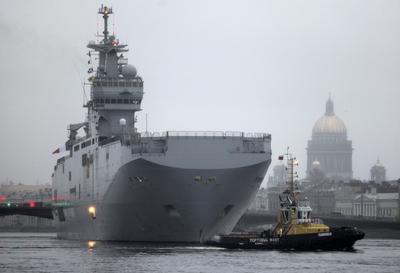The deal was preceded by three years of negotiations, and has elicited controversy inside and outside Russia.
Domestic criticisms focused on the high price tag of the purchase and its questionable contribution to the country’s defence. Several Russian commentators claimed that the project, lobbied personally by Russian President Dmitry Medvedev, only served the political objective of cementing Franco-Russian relations.
The Chairwoman of the House Foreign Affairs Committee in the US Congress, Ileana Ros-Lehtinen, issued a statement on 17 June berating France, a NATO member, because it ‘has decided to ignore the clear danger of selling advanced warships to Russia even as Moscow is taking an increasingly hostile approach toward the US … and Europe itself’. The governments of Georgia and Latvia have expressed similar apprehension.
A closer look reveals that the Mistral contract is very much in line with Russia’s evolving military doctrine, and does not threaten the US and its European allies.
Russia has embarked upon an ambitious program of rearmament, which aims to raise the level of modern weaponry and equipment across the armed forces to 70 per cent of the arsenal by 2020. This modernisation drive affects the navy in particular. In the past two decades it had acquired only four surface warships based on obsolete Soviet designs. Between 2010 and 2020 it is to receive fifty brand new ships. In December 2009, Prime Minister Vladimir Putin stated that this would demand ‘a qualitative breakthrough in the military shipbuilding industry’. Buying the Mistrals will undoubtedly enhance this core capability.
The French design is fairly universal: it combines the features of a helicopter carrier, marine landing platform, command-and-control ship and floating hospital. Russian shipyards simply cannot build such a modern ship quickly and independently at present. The Mistrals will be assembled in Brest with 20 to 40 per cent of the parts manufactured by Russian contractors. As part of the deal, Moscow has also obtained a license to build two such ships domestically in the future.
The first two Mistrals will be assigned to the Pacific Fleet, which is being transformed into the strongest component of the Russian navy and the core element of the Eastern Operational-Strategic Command set up in 2010. According to the Russian Deputy Minister of Defence responsible for armaments, it is the ships’ SENIT-9 combat information system rather than their assault capability which will be in demand in the years to come. The Mistrals will act as flagships for newly-commissioned naval assets as well as those transferred from the Northern Fleet, and will provide operational control to surface ships, submarines and the aviation and coastal defences that stretch from Vladivostok to Chukotka.
Over the past few days the Russian top brass have supplied further details on the tactical deployment and specific missions of the Mistrals. The Chief of General Staff has indicated that they will be used to protect the Kuril Islands, the sovereignty of which is disputed by Japan. This comes as no surprise — when Medvedev and his defence minister visited these territories in 2010 they were appalled to discover that they are garrisoned by ill-trained troops operating WWII-era equipment.
Other tasks include the defence of oil and gas infrastructure, patrolling of trade routes, anti-pirate and anti-terrorist activities, and search and rescue missions in the littoral areas notoriously vulnerable to seismic eruptions and tsunamis. There is a general consensus that the Mistrals will not be used for power projection beyond their area of responsibility in the Far East. They are not the harbingers of the restoration of Russia’s blue ocean navy that some fear will be capable of challenging US maritime supremacy. In fact, Russia has discontinued any work on heavy cruisers or specialised ‘aircraft carrier killers’.
One strategic rationale for the Mistrals’ deployment in the Pacific which is the proverbial elephant in the room for official Russian spokespersons, is the containment of China. Since Gorbachev’s time they have carefully avoided labelling their giant neighbour as a potential enemy. One rare exception was the answer given in 2009 by the Chief of the Ground Forces Staff to the question of what kind of warfare the national armed forces should prepare for: ‘If we talk about the east, then it could be a multi-million-man army with a traditional approach to conducting combat operations’. The strategic military exercise, Vostok-2010, conducted last year, simulated a response to an unnamed threat from the east as opposed to the habitual parrying of NATO. It was the largest event of its kind since 1991 and acknowledged the obvious: Russia cannot compete with China in conventional ground forces, and will have to rely on nuclear weapons and a strong navy to counter Beijing’s potential threat to Siberia and the Far East.
Kirill Nourzhanov is Senior Lecturer at the Centre for Arab and Islamic Studies, Australian National University.


The author argues that one of the strategic rationales for Russia to deploy the new warships in the Pacific lies in the containment of China. I wonder how the assault amphibious warships might be useful vis-a-vis China, given that Russia has only land border with the PRC.
Artyom
What is on the paper or in the air can’t be in reality. With continuing decline of Russian population in The Far East it will eventually fall into China’s hands
If you were a Russian would you be concerned about the over-bureaucratized, debt-ridden, squabbling Europeans or the Chinese, the fading power or the rising power? Their eastern front is vast and mineral rich. Seems reasonable they want to access better naval technology, but then why also sell plans for stealth fighters to the Chinese unless they are obsolete already?